Any list comprised of the most hotly debated and contested Hollywood and political films would lack in credibility if Oliver Stone’s JFK (USA 1991) did not make it into the Top 10. This becomes more and more obvious each time one watches the 3.5-hour labyrinthine conspiracy thriller – whether one believes in its interpretations or not. Stone established his position as one of the most original (and strong-willed) American mainstream directors during the 1980s, with Platoon (USA 1986) and Born on the Fourth of July (USA 1989) earning him personally two Oscars for Best Director. These films were directly related to the Vietnam War and more broadly to the generation traumatised by it, and JFK serves as a chronological prologue. The escalation of the war in Vietnam is often morphed into the assassination of President John F. Kennedy as a tragic continuation of the events that left many people dead or physically and emotionally scarred.
The aim of this article is to analyse JFK in light of what it has to say about the alleged conspiracy and some of the possible motives behind the assassination. Because the film is absolutely massive and full of minuscule facts, factoids and fiction, I have concentrated on some key or otherwise interesting scenes and their relation to the much debated narratives of the real events – in the motorcade and beyond. Additionally, I have highlighted certain aspects that, because of the brevity of their screen time, might go unnoticed with the first watching. In conclusion, I will briefly assess the significance of JFK to public awareness and researchers as well.
Garrison and Stone Hold Their Grounds
The assassination of John F. Kennedy in Dallas, Texas on 22 November 1963 is one of the most hotly debated events in the US – if not the world – history, as no-one has yet been able to prove without a reasonable doubt what really happened on that day (apart from the obvious). This is unlikely to happen in the future either, especially if the evidence really was tampered with and destroyed right after the fatal shots had rang out and if the number of the alleged culprits and other actors remains as is – in other words truly exhaustive. Conspiracy theories have a habit of staying long in people’s minds since they have been discredited by experts, and thus even ground-breaking new discoveries are unlikely to change the direction of the debate that has been polarised right from the beginning.
James ’Jim’ Carothers Garrison, who was New Orleans District Attorney at the time of the investigation, was one of those who publicly or privately questioned the conclusions of the Warren Commission, the verity of which even some of its members doubted. Garrison was convinced that the leftist radical Lee Harvey Oswald was a scapegoat that the main culprits of the murder managed to stage as the sole shooter. Garrison’s team[1] systematically started collecting evidence that could discredit ’lies’ and bring President Kennedy’s true murderers to face justice.
Evidence started mounting in such quantities that, finally, nearly all nationally significant institutions and organisations could have had a tenuous connection to the events at Dallas. The cover-up of all this would have been a much bigger, concerted operation than the assassination itself. Garrison had so many interconnected lines of investigation in his hands that in the end not even all his supporters wanted to believe in the vastness of the conspiracy.[2] Nevertheless, he stayed true to his stance that there was an unholy alliance – going all the way to the top of the American society – that acted out of fear that the Kennedys could break the old status quo marred by corruption and shady associates and give in to the communists.[3] And so Stone himself wants us to believe.
The public interest in such theories did not fade. The unsolvable narrative with all its variations has become part of the folklore of the American political game, and continues to inspire (non-)fiction writers and historians to write even several books per year. The act which has had perhaps the broadest significance, when the general public has construed its opinion(s) about the Kennedy assassination, came from a person who has divided filmgoers, critics and historians from early on. Film director and screenwriter Stone felt the need to filmatise the story of Garrison, and after a considerable production hell, JFK had its premiere in 1991. It received strong criticism even before its screenings had properly begun, but, not unlike Garrison himself, Stone used every avenue to defend his interpretations.
One can imagine the astonishment of those who were against the film when it received eight Academy Award nominations (and won in two categories), including for Best Picture and Best Director, other awards, and several mentions on newspaper and magazine lists of the best films of the year. Stone had proven to his critics that provocation can indeed have its own value.
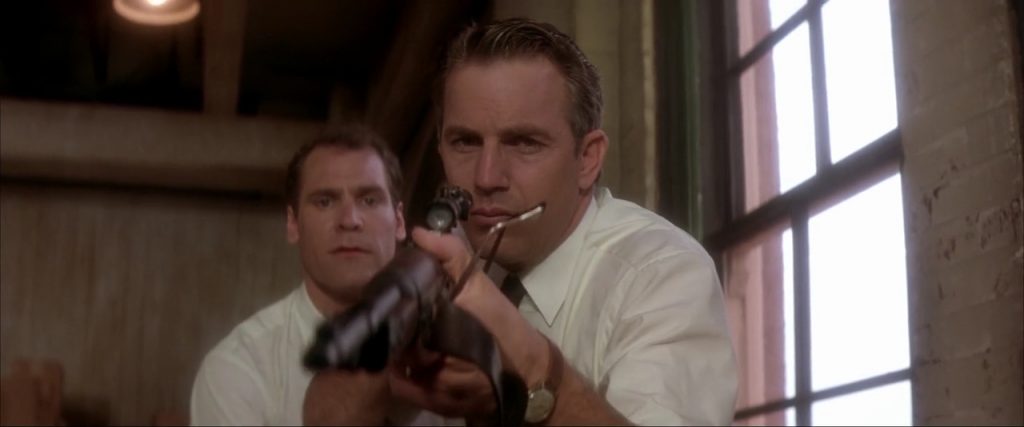
The Problematic Relationship of Fictionalisation and Semi-Documentary Style
Most of the critique faced by JFK was related to the way Stone had turned some individuals into composites and placed some others into situations that there at least were no proof of – and had overstated some aspects of the assassination. Some were vehement about Lee Harvey Oswald not seeming as guilty as the conclusions by the Warren Commission suggested. On the contrary, Stone paints him as a man of ideology that in the end was just one cog in the massive machinery that, according to Stone, was responsible for Kennedy’s murder. This interpretation may point in the right direction, but still Stone lets on that Oswald’s significance (especially to the Soviet Union) was greater than it possibly was.
Oswald’s wife Marina (Beata Pozniak) appears to be historically more ’accurate’ a character. Stone practically gave Pozniak (as he had done with Gary Oldman as well) a ’carte blanche’ to create the character, and even an interview with Marina Oswald was arranged for her.[4] These two women who had moved from behind the Iron Curtain in pursuit of the American Dream felt real sympathy of souls right from the first meeting, became friends, and so the film character became apparently ’truthful’ – confiding and misguided.[5] Thus, Marina Oswald Porter is a less remembered part of the tragedy that touched not just the Kennedy family but in some way many others as well.[6]
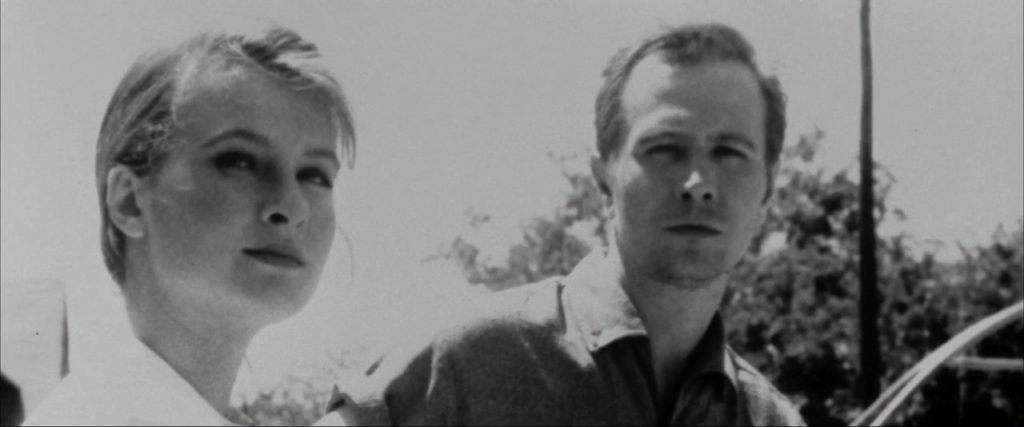
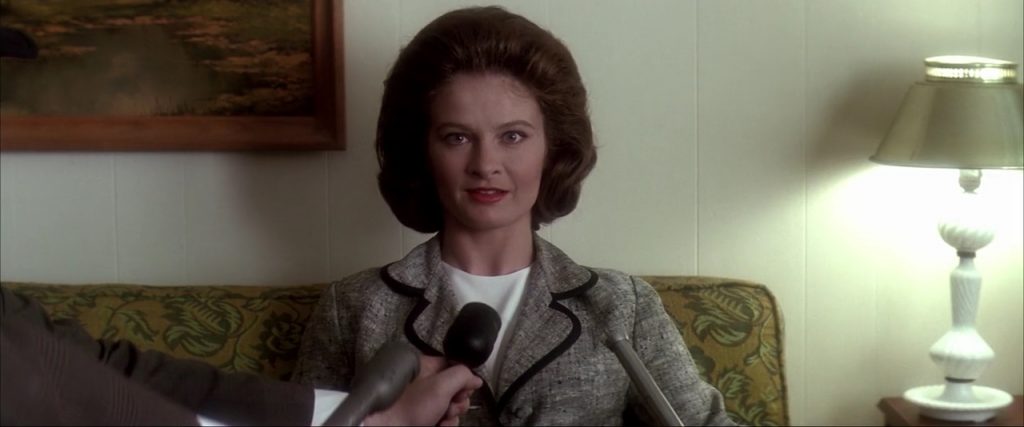
Stone suggests that by arresting Oswald, the Dallas Police Department let at least one other suspect slip away. Oswald himself managed to get away from the school book depository to a movie theatre, and the order for his arrest was not first even acted upon. Thomas G. Buchanan wrote about this as early as 1964[7], and a very detailed narrative of Oswald’s movements immediately after exiting the depository can be found in, say, David E. Kaiser’s book The Road to Dallas[8]. In light of these factual narratives, some of the scenes Stone created around Oswald appear credible, but there are those as well that have the function of adding yet more dramatic touches to the story that is full of thriller elements and political tensions. For example, Oswald’s alleged connection to ’Operation Mongoose’, in which the CIA is claimed to have trained anti-Castro Cubans for a new Bay of the Pigs-like landing attempt, has been called into question[9], but in Stone’s flash-back sequences Oswald is present on the training ground.
Those with the most crushing opinions about JFK at the time of its release[10] perhaps deliberately forgot they had watched a semi-fictional filmic interpretation, not a documentary film. As a director of mainly historical-political feature films (and documentaries), Stone has every right to combine facts, factoids, composites, his own conclusions and pure fiction without needing to justify his decisions with the same kind of thoroughness as a professional historian. And yet, Stone manages to utilise less than solid speculation in unison with more robust theories – and takes into account information from the decades preceding the events of Dallas.
For example, there is evidence about the ties between the CIA and the Mafia from the closing stages of the Second World War onwards. Thus, there might be a theoretical possibility that these actors on the opposite side of law operated in unison to murder Kennedy – as they had done in the case of Fidel Castro.[11] Stone brings up the role of organised crime a bit more forcefully than Garrison did in his book On the Trail of the Assassins – potentially because of Garrison’s own, alleged Mafia connections. In this context, it is worth noting that Jack Ruby’s[12] connections to the Mafia were practically left outside the investigation, although he was suspected of having acted for the CIA.[13]
The Homeless Tramps of the CIA and Other Absurdities
It does not come as a surprise that Stone’s film includes speculative details, the impossibility of which had been proven almost beyond doubt even before the filming of JFK had started. One of the wildest assumptions concerns the three tramps that were found sleeping in a nearby metro station soon after the assassination. This mundane case suddenly made it into the headlines when the claim that the trio was in fact undercover agents working for the CIA started to gain publicity. To no avail, the detractors of this theory tried to give proof that it would have been impossible for some well-to-do agents to transform themselves quickly into men that had been sleeping rough for a long time. The press photos of the homeless trio were thoroughly analysed – with some of the investigators supporting the claim and some shooting it down immediately.[14] This is just one example of the many red herrings that potentially led the investigators way off the track. The trio appears momentarily in black-and-white flashbacks on JFK but remains an anecdotal detail rather than a really substantial clue in the screen Garrison’s case.
A courtroom scene, in which the fateful seconds of the famous Zapruder film are repeated over and over again, is definitely one of the quintessential key moments of JFK. The image analysis of the Zapruder film played a big part in Jim Garrison’s investigation in real life as well, because to him it proved that the last and fatal shot came from the front (’back and to the left… back and to the left…’). (The screen) Garrison’s interpretation would suggest there was more than one shooter and that the fatal bullet came from the ’grassy knoll’, not from the school book depository’s window.[15] A couple of eyewitnesses claimed they saw an unknown person running away from the railway bridge that had been emptied of people and traffic as the presidential motorcade rode under it. Thomas Buchanan brings this up and, in my opinion, also manages to state convincingly that, without the hand of some unknown crack sniper, it is unlikely that the lethal shot came from the sixth floor, as Oswald was using an Italian ’Carcano’ (’Modello 91’), a bolt-action infantry rifle that has an average firing speed.[16] All things considered, Stone dismisses the single-shooter theory with much force by promoting speculation about several individuals ( ’maybe three teams ’) working in unison and creating a kill zone.
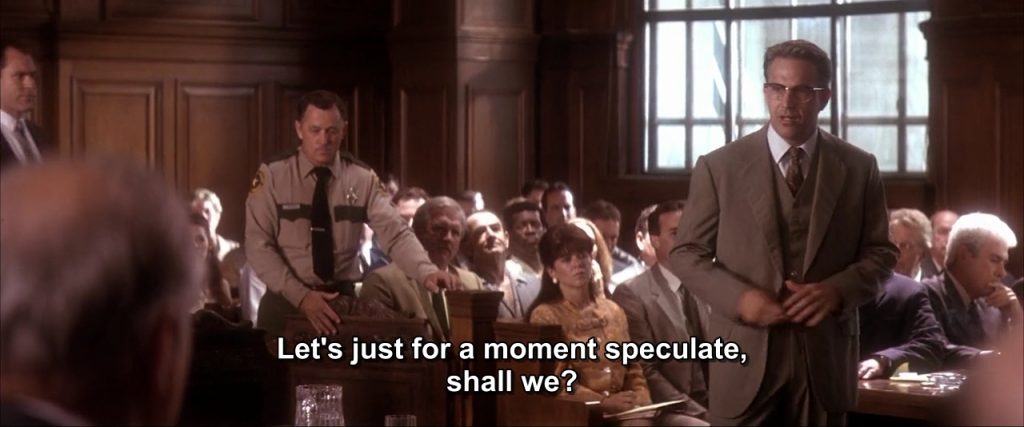
In the film and in real life, the afore-mentioned speculations about the sniper’s location strengthen the supposition that the Dallas Police Department and possibly the CIA and the FBI as well were at least aware of the possible anti-Kennedy conspiracy and did everything in their power to hinder and send the neutral investigation on a wild goose chase.[17] Especially the bullet that was found on Kennedy’s stretcher and was claimed to have travelled through both Kennedy’s head and the windshield in an almost pristine condition has raised many questions about the role of the authorities in the events. Although details such as this still result in contradicting conclusions, what happened in the Kennedy motorcade during the shots and the immediate aftermath has been ’reconstructed’ into Stone’s film in a manner similar to e. g. the narrative in William Manchester’s seminal book The Death of a President.[18]
An Innocent Man on Trial?
The peak of JFK’s dramatic arch is not hard to find, as Jim Garrison’s investigations aim at one thing only – bringing the culprits to face justice. When he and his team finally manages to sue a person they claim is part of the conspiracy, the viewer, too, may feel some kind of exultation as the months’ ceaseless toil seems to pay off at last. All this considered, it is quite hard to accept the historically accurate anti-climax of the film, when the accused is freed of the charges by jury – and at a record time for that.[19] But that is not the whole story.
The year was 1969 and the protagonist of the said trial a wealthy businessman Clay L. Shaw. Garrison claimed he had operated with an alias ’Clay Bertrand’ while participating in the planning of the Kennedy assassination with Lee Harvey Oswald and David Ferrie. The latter, who was to be a key person in Garrison’s case, had, alas, died by then[20], and accordingly Garrison badly needed new fuel to bring about his JFK trial. The answer to his needs was the homosexual Shaw, who, as played by Tommy Lee Jones, becomes a very off-putting, two-faced character.
Clay Shaw was a respected person in the French Quarter of New Orleans, because, thanks to him, many of its historical buildings got renovated. He distinguished himself as an active patron of fine arts and even wrote a few stage plays. In addition, he was a registered Democratic voter who in 1960 had supported Kennedy’s victorious campaign and openly praised his personality and achievements. As a business man he was one of the founders of the International Trade Mart. It is unlikely that such a man would in some capacity have participated in the anti-Kennedy conspiracy. In addition, the charges made by Garrison against Shaw are not that persuasive: only homosexuality, proficiency in Spanish language and the same given name linked him to the mystical ’Clay Bertrand’, who probably was a figment of Dean Andrews’[21] imagination.[22]
Nevertheless, Oliver Stone makes Shaw confess to the police that he used the said alias – and Garrison almost attacks him in the interrogation that, according to the real Shaw, was conducted in a sober, relaxed atmosphere. In addition, a gangster says to an investigator working under Garrison that everyone in the French Quarter knew Shaw had used the alias ’Clay Bertrand’. In reality, Garrison could not find a single credible witness to corroborate the alleged Shaw-Bertrand connection in the two years that passed between Shaw’s arrest and release.[23] No wonder the trial is considered one of the most shameful in the history of the US justice system.[24] On the one hand, Stone wanted to make Garrison look like a quintessentially American family man hero fighting against all odds, and Shaw, on the other hand, a despicable, twisted anti-patriot, so Stone needed an ending that would support Garrison in the moment of defeat. In order to create that, he made Shaw a guilty person who was acquitted only because the pivotal witnesses did not agree to come to the court to testify.
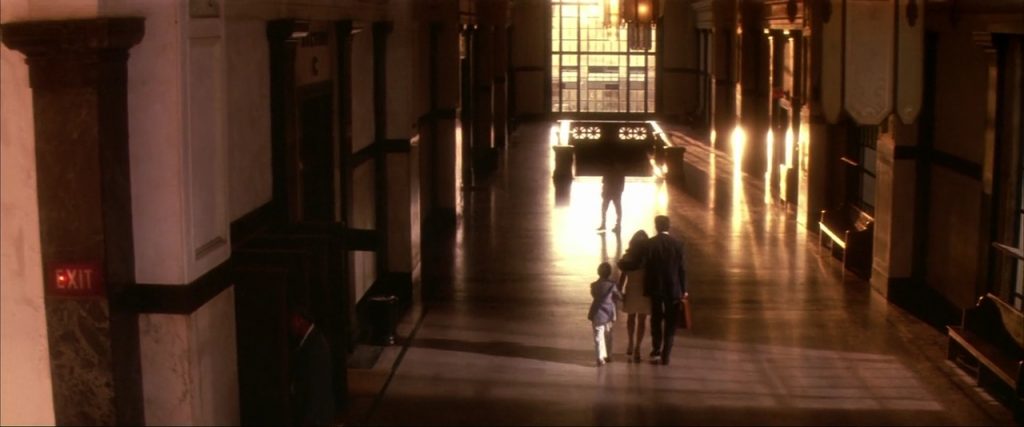
The After-Effects of JFK
Almost three decades have passed since the premiere of Oliver Stone’s JFK, so it is topical to ponder its cultural and historical impact. It is easy to accuse it of multiple ’errors’, some of which are copied exactly as they appeared in Garrison’s own book On the Trail of the Assassins. Even the choosing of Garrison as a protagonist launched a storm of criticism, as many film critics and experts held him as a liar who first made up a theory and only then started to search for some clues to support his claims. Even some supporters of ’Big Jim’ did not approve the way Stone treated the claims that were contradictory to Garrison’s theories.[25] Whereas Garrison appears to have bended the ’truth’ to match his evidence, Stone did something similar in the name of artistic license (which is not something that should be outright condemned). True or not, the JFK conspiracy theories witnessed a true renaissance, partly thanks to Stone’s film.
In his book, David E. Kaiser brings forth both the positive and the negative impacts: without the release of JFK, the Kennedy Assassination Records Act would probably not have passed back then, and the author himself admits great gratitude for getting access to a massive amount of documents. At the same time, Kaiser reminds that the aspects of the conspiracy Stone chose to emphasise were at least a decade old at the time of the premiere, and hence the film brought the audience’s understanding of the assassination and its cover-up back to the level from which researchers had tried, with great toil and effort, to raise it up. Not surprisingly, on the positive side of things, Kaiser says directly that without the film’s effect on the legislative process, the writing of The Road to Dallas would not have been possible.[26]
To sum up, it can be stated that JFK is among the most divisive political-historical films, which, regardless of the partly stinging criticism, is valued as a modern classic of its genre. In fact, it is not a mere film, because a whole phenomenon spawned out of it, even after the hostile first reactions. Personally, I regard Stone’s film as a remarkable tour de force from a director who was deployed in Vietnam when the actual events occurred and did not much delve into them before beginning to write the screenplay. Professional historians may critisise JFK for many details that were, in one way or another, created in order to achieve an effective dramatic arch, but its impact is much bigger than the sum total of those parts that have been called into question. JFK is a fictional metaphor for all those suspicions and questions that are still hanging in the air – partly because of the insufficient investigation carried out in the aftermath of the assassination. A ’political detective story’ that trips the viewer many times over and, with its very fast editing and ceaseless unrolling of information, creates an atmosphere of paranoia that is very hard to shake off.
Taneli Hiltunen is a post-graduate student at the School of History, Culture and Arts Studies (major: World and European History) at the University of Turku, Finland. He is currently working on doctoral dissertation about the Victorian battle accounts of the Mahdist War.
Bibliography
Primary Sources
JFK (USA 1991). Director: Oliver Stone. Screenplay: Oliver Stone & Zachary Sklar. Principal cast: Kevin Costner (Jim Garrison), Gary Oldman (Lee Harvey Oswald), Beata Pozniak (Marina Oswald), Tommy Lee Jones (Clay Shaw), Sissy Spacek (Liz Garrison). Production company: Warner Bros. Running time: 205 min (Director’s Cut Blu-ray).
Research Literature
Buchanan, Thomas G. Kuka murhasi Kennedyn? [Who Killed Kennedy?] Tammi, Helsinki 1964.
Kaiser, David E. The Road to Dallas. The Belknap Press of Harvard University Press 2008.
Manchester, William. The Death of a President, November 20–November 25, 1963. Harper & Row, New York 1967.
McAdams, John. Kennedy Assassination Home Page. http://mcadams.posc.mu.edu/ Specific addresses in the notes.
Scheim, David E. Contract on America – The Mafia Murder of John F. Kennedy. Shapolsky Publishers, Inc 1988.
Reitzes,
Dave. JFK Online. www.jfk-online.com.
Specific addresses in the notes.
[1] Stone appears to make a deliberate nod to the gender equality debate by making a fictional character ’Susie Cox’ part of Garrison’s inner circle. Apart from that, JFK does not have anything obvious to do directly with the opinion climate of its own time. Actually, it feels like a film that could have been made in the 1970s already.
[2] A comprehensive list of the organisations that Garrison suspected of having a link to the murder of President Kennedy can be found here: http://mcadams.posc.mu.edu/suspects.htm.
[3] The massive amounts of dollars spent on the war in Vietnam on Lyndon B. Johnson’s presidential term, to which ’Mr. X’ alludes to, may be an indication of the said fear. Stone’s representation of Kennedy as a kind of ’martyr saint of liberalism’ is more vulnerable to criticism. For further details, see e. g. http://mcadams.posc.mu.edu/stjohn.htm.
[4] Beata Pozniak had several long conversations with Jim Garrison as well, who was taken by surprise by her observations about Marina Oswald. In addition, Pozniak read the reports of the Warren Commission in their entirety, contemporary press articles (e. g. Newsweek and Time) and went through archive material concerning Marina. http://www.jfk-online.com/jfkpozniak.html
[5] http://www.jfk-online.com/jfkpozniak.html
[6] For an episodic and moving drama film about the events of the fateful day, see Parkland (USA 2013). The protagonists include e.g. Abraham Zapruder , nurse Doris Nelson from the Parkland Memorial Hospital, and Lee Harvey’s brother Robert Oswald,.
[7] Buchanan 1964, 192–193.
[8] Kaiser 2008, 366–370.
[9] SeeKaiser 2008, 97–122.
[10] For a comprehensive collection of contemporary newspaper and magazine articles, reactions and commentaries connected with the debate around JFK, see JFK: The Book of the Film (Applause Books, New York 1992) which includes the documented screenplay by Oliver Stone and Zachary Sklar and a second section called ’The JFK Debate: Reactions and Commentaries’ with 97 commentators, including Norman Mailer and former President Gerald R. Ford.
[11] Scheim 1988, 190–195.
[12] The man who shot Oswald while the television cameras were rolling.
[13] Scheim 1988, 48–50.
[14] ’JFK Assassination a Hobo Hit? The Three Tramps’. http://mcadams.posc.mu.edu/3tramps.htm
[15] Kaiser 2008, 377; since then dismissed as an erroneous conclusion.
[16] Buchanan 1964, 84–92.
[17] It should be noted, however, that Kaiser claims there is no indication of any CIA involvement in the assassination, but right after this he admits the CIA’s efforts to maintain secrecy over the identity of its contacts prevents from saying anything certain about the possible connections between Oswald and the CIA. Kaiser 2008, 416.
[18] Manchester 1967, 155–164.
[19] Scheim 2008, 48.
[20] According to a claim by the District Attorney, Ferrie either committed suicide or was murdered. This has been proven wrong, but the film refers only to Garrison’s theory on the matter. For a more objective take, see e. g. http://www.jfk-online.com/ferriedeath.html.
[21] One of Garrison’s colleagues.
[22] http://www.jfk-online.com/jfk100bertrand.html
[23] http://www.jfk-online.com/jfk100bertwit.html
[24] Kaiser 2008, 237.
[25] http://www.jfk-online.com/jfk100bigjim.html
[26] Kaiser 2008, 419.